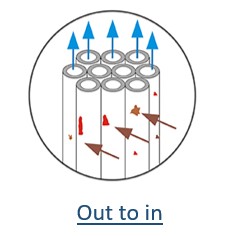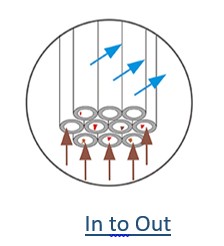REOS Ultra Filtration (UF) system preferentially separates and concentrates suspended solids, bacteria, some proteins, pigments, colloids and constituents that have a larger molecular weight from the most challenging waste and feed water applications. Ultrafiltration system work almost like any other water filtration system. In a sediment filter, water flows through and captures particulate with the porosity of the filter. An ultrafiltration system works in the same way except that it filters anything larger than 0.025 micron, which is much more than your average sediment filter. REOS Ultra Filtration system are fully pre-assembled, pre tested and arrive at your site in fully ready condition.
.jpeg)
ULTRA FILTRATION MEMBRANE
UF membranes may be constructed from a wide variety of materials, including cellulose acetate, polyvinylidene fluoride, polyacrylonitrile, polypropylene, polysulfone, polyethersulfone, or other polymers. Each of these materials has different properties with respect to the surface charge, degree of hydrophobicity, pH and oxidant tolerance, strength and flexibility. Membrane filters are usually manufactured as flat sheet stock or as hollow fibres and then formed into several different types of membrane modules. Module construction typically involves potting or sealing the membrane material into an assembly, such as with hollow-fibre module. These modules are comprised of hollow-fibre membranes, which are long and very narrow tubes that may be constructed of membrane materials described previously. The fibres may be bundled in one of several different arrangements. REOS (UF) uses a specialized membrane material shown in below figure. UF membrane modules may operate in an “inside-out” or “outside-in” mode. In inside out mode, feed water enters the centre of the fibre and is filtered radially through the fibre wall. Filtrate is then collected from outside the fibre. During outside-in operation, feed water passes from outside the fibre to the inside, where filtrate is collected in the centre of the fibre. When a UF membrane module is operated in an inside-out mode, pressurized feed water may enter the centre of the fibre at either end of the module, while filtrate exits through a port located at the centre or end of the module. In outside-in mode, feed water typically enters the module through an inlet port located in the centre and is filtered into the centre of the fibre, where the filtrate exits through a port at one end of the module. Most UF system operate in direct filtration mode and are periodically backwashed to remove the accumulated solids

The raw water flows into the external of hollow fibre UF membrane from one end of the membrane, and water, small molecules and ions form an ultra-filtrate through the membrane wall under the action of pressure to the Internal membrane. Large particles such as macromolecules, suspended solids and colloids are trapped outside the membrane silk to achieve ultrafiltration filtration

The raw water flows into the internal of hollow fibre UF membrane from one end of the membrane, and water, small molecules and ions form an ultra-filtrate through the membrane wall under the action of pressure to the external membrane. Large particles such as macromolecules, suspended solids and colloids are trapped inside the membrane silk to achieve ultrafiltration filtration
BACKWASHING
The backwash process is designed to remove contaminants accumulated on the membrane. During backwash, the direction of flow is reverse for 30 seconds to 3 minutes. The force and direction of the flow dislodge the contaminants at the membrane surface and wash accumulated solids out through the discharge line. Membrane filtration system are 15 to 60 minutes between backwash events. The backwash process reduces system productivity 5 to 10 percent due to the volume of filtrate used during backwash. Backwashing is almost exclusively associated with UF processes.
Features
Applications